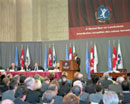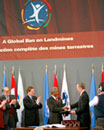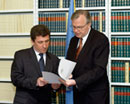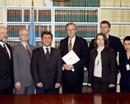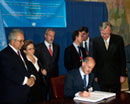|
Convention on the Prohibition of the Use, Stockpiling, Production and Transfer of Anti-Personnel Mines and on their Destruction
Oslo, 18 September 1997
By Stuart Casey-Maslen
International lawyer Landmine and Cluster Munition Monitor's mine action editor, Norwegian People's Aid
The context of the adoption of the Convention on the Prohibition of the Use, Stockpiling, Production and Transfer of Anti-Personnel Mines and Their Destruction (Anti-Personnel Mine Ban Convention)
The Anti-Personnel Mine Ban Convention is an instrument of international law that prohibits the development, production, stockpiling, transfer, and use of anti-personnel mines. The Convention entered into force on 1 March 2009. It was the result of the “Ottawa Process”, a freestanding process of treaty negotiation outside a United Nations-facilitated forum with the aim of outlawing anti-personnel mines. The process was so called because it was launched in Ottawa by the Minister of Foreign Affairs of Canada in October 1996. Despite widespread use of anti-personnel mines in the Second World War, the 1949 Geneva Conventions only addressed issues of mine clearance, prohibiting expressly the forcible use of prisoners of war for such purposes. In the mid-1970s, a series of three meetings convened by the International Committee of the Red Cross (ICRC) to discuss a variety of conventional weapons identified landmines (in general) as a means of warfare deserving particular legal regulation. It had been hoped that the use of certain conventional weapons would be specifically restricted by the 1977 Additional Protocols to the Geneva Conventions, but final agreement remained elusive and, as a consequence, a separate conference was convened under the auspices of the United Nations to negotiate a distinct legal instrument. The result was the adoption in 1980 of the Convention on Prohibitions or Restrictions on the Use of Certain Conventional Weapons Which May be Deemed to Be Excessively Injurious or to Have Indiscriminate Effects, as amended on 21 December 2001 (Convention on Certain Conventional Weapons), one protocol of which (Protocol II) governed “mines, booby-traps and other devices”. In 1993, as international concern escalated over the impact of anti-personnel mines on the civilian population in many conflict-affected areas, France called for a review conference of the Convention. After three years of difficult negotiations under the auspices of the United Nations, the States parties to the Convention on Certain Conventional Weapons adopted an amended Protocol II, which placed tighter controls on the use and transfer of anti-personnel mines. The 1996 Amended Protocol II, however, fell short of the total prohibition that civil society, the United Nations Secretary-General, the ICRC, and an increasing number of Governments were advocating. At the meeting that adopted the amended protocol, Canada announced that it would convene a meeting to discuss how to achieve an international ban on anti-personnel mines. The International Strategy Conference: Towards a Global Ban on Anti-Personnel Mines (the 1996 Ottawa Conference), was held in the Canadian capital from 3 to 5 October 1996. At the closing session of the Conference, the then-Minister of Foreign Affairs, Lloyd Axworthy, called for the negotiation and signature of a treaty outlawing anti-personnel mines by the end of 1997. The Austrian delegation to the 1996 Ottawa Conference already had a first draft of an anti-personnel mine ban convention with them, but although they referred to it in their remarks, they did not circulate it formally. The draft, with only minor alterations but now entitled “the Austrian draft text”, was sent out worldwide in November 1996. To support what was now called the Ottawa Process, a “core group” of friendly States was assembled, bringing together, initially, Austria, Belgium, Canada, Ireland, Mexico, the Netherlands, Norway, the Philippines, South Africa and Switzerland. By 1996, the United Nations General Assembly had already adopted a number of resolutions relating to anti-personnel mines. A call for a moratorium on the export of anti-personnel mines was contained in the first operative paragraph of resolution 48/75K, adopted without a vote on 16 December 1993. On 10 December 1996, resolution 51/45S, which attracted 115 co-sponsors, was adopted by 155 votes to none, with 10 abstentions. Its first operative paragraph urged States “to pursue vigorously an effective, legally binding international agreement to ban the use, stockpiling, production and transfer of anti-personnel landmines with a view to completing the negotiation as soon as possible”. The Expert Meeting on the Text of a Convention to Ban Anti-Personnel Mines, held in Vienna, Austria, from 12 to 14 February 1997 provided States with an initial opportunity to comment directly on Austria’s first draft of the Convention. Based on the comments received, Austria prepared a second “tentative” draft of its treaty text on 7 March 1997 and circulated it to the core group. The second Austrian draft was completed on 14 March 1997. The International Expert Meeting on Possible Verification Measures to Ban Anti-Personnel Landmines, the second formal follow-up gathering to the 1996 Ottawa Conference, was held in Bonn from 24 to 25 April 1997. Views remained divided between States who believed that detailed verification was essential to ensure that any agreement was effective, and others that argued that the proposed agreement was essentially humanitarian in character and stressing the overriding importance of a clear norm prohibiting anti-personnel mines. Austria circulated its third draft on 28 April 1997 to the core group and then, after revision, especially concerning compliance issues, issued the text on 14 May 1997. The International Conference for a Global Ban on Anti-Personnel Mines, held in Brussels in June 1997 (the Brussels Conference), provided a selection process for participation in the forthcoming diplomatic conference, and formally identified the third Austrian draft as the basis for its negotiations. Ninety-seven of the one hundred and fifty-six States attending the Brussels Conference signed the Brussels Declaration, which affirmed that the essential elements of a treaty to ban anti-personnel mines were: a comprehensive ban on the use, stockpiling, production and transfer of anti-personnel mines; the destruction of all stockpiled and cleared anti-personnel mines; and international cooperation and assistance in the area of mine clearance in affected countries. The Brussels Declaration also referred to the convening of the diplomatic conference to adopt the treaty and confirmed that the third Austrian draft would be the basis of negotiations at the conference. The Diplomatic Conference on an International Total Ban on Anti-Personnel Land Mines (the Oslo Diplomatic Conference), convened by Norway, opened on 1 September 1997, and was chaired by Jacob Selebi, the South African Ambassador to the Conference on Disarmament in Geneva. At the opening of the Oslo Diplomatic Conference, delegates observed a minute’s silence in memory of Diana, the Princess of Wales, who had been very active in the fight against landmines and had died in a car crash in Paris the weekend before. On 18 September 1997, after three weeks of negotiations, the Convention was formally adopted. The Anti-Personnel Mine Ban Convention aims to put an end to the suffering and casualties caused by anti-personnel mines. It does so by obliging States parties never to use, develop, produce, stockpile or transfer anti-personnel mines, and by requiring that they destroy existing stocks of anti-personnel mines, clear mined areas, and assist victims. In fulfilling their obligations, States parties in need may request assistance, and States parties “in a position to do so” are to provide assistance (article 6). A variety of mechanisms exist, or have been established, to support these cooperation and assistance provisions. The Convention defines a mine as “a munition designed to be placed under, on or near the ground or other surface area and to be exploded by the presence, proximity or contact of a person or a vehicle”. An anti-personnel mine is in turn defined as a “mine designed to be exploded by the presence, proximity or contact of a person and that will incapacitate, injure or kill one or more persons”. The definition of an anti-personnel mine is, though, qualified by the provision that “[m]ines designed to be detonated by the presence, proximity or contact of a vehicle, as opposed to a person, that are equipped with anti-handling devices, are not considered anti-personnel mines as a result of being so equipped” (article 2). A State must destroy all anti-personnel mine stockpiles it owns or possesses or that are under its jurisdiction or control “as soon as possible but not later than four years” after it becomes a party to the Anti-Personnel Mine Ban Convention (article 4). The term “jurisdiction” typically covers the whole of the sovereign territory of a State party (even where the stockpiles may belong to another State); the term “control” may apply extra-territorially, for instance if a State party occupies territory belonging to another State and gains control of stockpiles of antipersonnel mines in the process. States parties may retain and transfer some anti-personnel mines—“the minimum number absolutely necessary”—for the specific purposes of “the development of and training in mine detection, mine clearance, or mine destruction techniques”. It is also permitted to transfer anti-personnel mines for the purpose of their destruction (article 3). Each State is obliged to clear all emplaced anti-personnel mines in mined areas under its jurisdiction or control as soon as possible but not later than 10 years after it becomes a party to the Convention (article 5.1). A mined area is defined as any area that is dangerous because of the presence or suspected presence of mines (article 2.5). While clearance operations are ongoing, a State party affected by emplaced anti-personnel mines must “make every effort to identify all areas under its jurisdiction or control in which anti-personnel mines are known or suspected to be emplaced” and must then perimeter-mark, monitor and protect by fencing or other means to ensure the effective exclusion of civilians (article 5.2). The Convention was drafted to take account of the fact that some States might not be able to comply with the 10-year deadline, for example because of the level of contamination or available capacity and resources. For this reason, it is possible for a State party to apply for an extension period of up to 10 years at a time (see further below). The Anti-Personnel Mine Ban Convention determined that there would be annual meetings of States parties until the First Review Conference, which was held in 2004, five years after the Convention’s entry into force. The practice of annual meetings of States parties, supported by informal “intersessional standing committees” was continued until the Second Review Conference, held in late 2009 (see further below). States parties at the Second Review Conference again decided that annual meetings would be held until the Third Review Conference, due to be held in 2014. It is not possible to make any reservations to the provisions of the Convention. That means a State party is not permitted to exclude or reduce the application of any of the Convention’s provisions: all 22 articles are fully applicable to every State party. A total of 122 States signed the Convention when it was opened for signature in Ottawa on 3 and 4 December 1997. As noted above, it entered into force on 1 March 2009, after the requisite number of ratifications or accessions (40) were deposited with the United Nations Secretary-General. By March 2010, 156 States—more than three-quarters of the world’s nations—had become parties to it. Certain major military powers, however, including three of the five permanent members of the United Nations Security Council (China, the Russian Federation, and the United States of America) have not joined the Convention, although they are de facto respecting many of its provisions. On 2 December 2009, the United Nations General Assembly adopted resolution 64/56 on the Implementation of the Convention on the Prohibition of the Use, Stockpiling, Production and Transfer of Anti-personnel Mines and on Their Destruction. The resolution was adopted by a recorded vote of 160 in favour to none against, with 18 abstentions (including the Russian Federation and the United States). Among those voting in favour, 19 States, including China, were not parties to the Anti-Personnel Mine Ban Convention (see report of the First Committee, A/64/391). As noted above, two major obligations under the Anti-Personnel Mine Ban Convention are to destroy stockpiles of anti-personnel mines and to destroy anti-personnel mines in mined areas under the jurisdiction or control of a State party. At the Ninth Meeting of States Parties to the Convention in November 2008, fifteen States parties requested and were granted an extension to their deadlines for destruction of anti-personnel mines in mined areas under article 5 of the Convention. At the Second Review Conference of the Convention, held in Cartagena, Colombia, from 30 November to 4 December 2009, a further four States parties requested and were granted an extension to their article 5 deadlines. The report prepared by the Convention’s Implementation Support Unit for the Second Review Conference stated that more than four-fifths of the world’s States no longer stockpile anti-personnel mines and that the States parties together have destroyed more than 42 million mines. The report also noted that since the First Review Conference in Nairobi, Kenya, in 2004, four States parties had missed their deadlines for the destruction of stockpiled anti-personnel mines, with three of them remaining non-compliant as of December 2009. The Anti-Personnel Mine Ban Convention has served as an important point of reference for subsequent negotiations on weapons. In particular, many of the provisions included in the Convention on Cluster Munitions, adopted in Dublin on 30 May 2008 (entry into force: 1 August 2010), are drawn from, or inspired by, those set out in the Anti-Personnel Mine Ban Convention. The similarities between the so-called Oslo Process on cluster munitions and the Ottawa Process on anti-personnel mines are notable. Both were launched by a single State, supported by a core group of other States committed to a prohibition (i.e. a return to the traditional approach of elaborating new rules of international humanitarian law), and both resultant treaties were adopted by a diplomatic conference convened outside the United Nations. This Introductory Note was written in March 2010.
Related Material
In 1980, a diplomatic conference held in Geneva adopted the Convention on Prohibitions or Restrictions on the Use of Certain Conventional Weapons Which May Be Deemed to Be Excessively Injurious or to Have Indiscriminate Effects, together with additional protocols, including a Protocol on Prohibitions or Restrictions on the Use of Mines, Booby Traps and Other Devices (Protocol II). This Protocol did not, however, establish a complete ban on anti-personnel mines. At the second session of the First Review Conference of the States Parties to the Convention, which was held in Geneva from 22 April to 3 May 1996, States parties amended Protocol II, thereby reinforcing the prohibitions contained therein (see Final Document of the Review Conference, CCW/CONF.I/16). However, Protocol II as amended still fell short of completely prohibiting anti-personnel mines, even though an increasing number of States had been advocating in favour of such a ban. At the end of the Conference, the Canadian delegation announced that Canada would host a meeting of countries in favour of a total ban later in the year of 1996 to develop a strategy to move the international community towards a global ban on anti-personnel mines. The Canadian Government accordingly decided to hold an international conference at Ottawa in September 1996 (see Report of the Secretary-General, “Moratorium on the export of anti-personnel landmines”, A/51/313). The International Strategy Conference “Towards a Global Ban on Anti-Personnel Mines” was held in Ottawa, Canada, from 3 to 5 October 1996. It led to the adoption of the Declaration of the Ottawa Conference, by which the 50 participating States, known as the “Ottawa Group”, agreed to enhance cooperation and coordination of efforts to achieve their goals, including the earliest possible conclusion of a legally binding international agreement to ban anti-personnel mines. The Conference also adopted an action plan outlining concrete activities which States, international organizations and non-governmental organizations were willing to take towards this goal, and decided to hold a follow-on conference in Brussels in June 1997. Further, the Government of Canada expressed its intention to host a treaty-signing conference in December 1997. The Ottawa Conference set the scene for a fast-track negotiation process towards the adoption of a treaty banning anti-personnel mines, known as the “Ottawa process”. The Declaration of the Ottawa Conference was annexed to a letter dated 16 October 1996 from the Representative and Ambassador of Canada to the United Nations for Disarmament to the Secretary-General, which was circulated as an official United Nations document (A/C.1/51/10) for the fifty-first session of the General Assembly. In November 1996, a few weeks after the closing of the Ottawa Conference, the Austrian Government circulated through its embassies a first draft of a treaty, which contained clear prohibitions of the development, production, stockpiling, transfer and use of anti-personnel mines. At the fifty-first session of the General Assembly, the question of the promotion of an agreement banning anti-personnel mines was discussed by the First Committee under the agenda item entitled “General and complete disarmament”. On 4 November 1996, the United States introduced a draft resolution entitled “An international agreement to ban anti-personnel landmines” with eighty-four co-sponsors (A/C.1/51/L.46). On 13 November 1996, the First Committee adopted the draft resolution and recommended it to the General Assembly for adoption (see A/51/566/Add.11). The General Assembly accordingly adopted resolution 51/45 S of 10 December 1996, in which it urged Member States “to pursue vigorously an effective, legally binding international agreement to ban the use, stockpiling, production and transfer of anti-personnel landmines with a view to completing the negotiations as soon as possible”. It also requested the Secretary-General to prepare a report on the steps taken to complete an international agreement concerning the issue and submit it at the fifty-second session. The Austrian Government decided to host a governmental meeting in February 1997 in Vienna to enable States to exchange views on the content of the circulated draft, to which it invited States, the United Nations and non-governmental organizations, including the International Committee of the Red Cross and the International Campaign to Ban Landmines. The Expert Meeting on the Text of a Convention to Ban Anti-Personnel Mines was held in Vienna from 12 to 14 February 1997. After discussions at the meeting, Austria revised its original draft and issued a second draft on 14 March 1997, which was again circulated for comments. As the negotiations at the Vienna meeting had made it clear that the question of possible verification measures would give rise to considerable debate among States, Germany decided to host a governmental meeting which would be devoted exclusively to this question. The International Expert Meeting on Possible Verification Measures to Ban Anti-Personnel Landmines was held on 24 and 25 April 1997 in Bonn. A final version of the Austrian draft was issued for circulation on 13 May 1997. The official follow-on conference to the Ottawa Conference, the International Conference for a Global Ban on Anti-Personnel Mines, was held from 24 to 27 June 1997 in Brussels, Belgium. The Conference produced the Declaration for the Brussels Conference on Anti-Personnel Mines, which was signed by 97 States out of 156. In the Declaration, the participating States agreed on the Austrian draft as a basis for negotiation, welcomed the convening of a diplomatic conference by the Government of Norway in Oslo, and decided to forward the Austrian draft for consideration and adoption at the forthcoming diplomatic conference. The Declaration also reaffirmed the goal of signing a treaty banning anti-personnel mines in Ottawa before the end of 1997. The Brussels Declaration was later transmitted to the Conference on Disarmament by a letter dated 9 July 1997 by the Office of the Permanent Representative of Belgium to the Conference on Disarmament (CD/1467) and was circulated as an official document of the Conference on Disarmament. On 1 September 1997, the Diplomatic Conference on an International Total Ban on Anti-Personnel Land Mines was convened in Oslo, Norway, as scheduled. The Conference had before it the third Austrian draft treaty as the starting point of the negotiations. The Conference lasted three weeks and adopted the final text of the Convention on the Prohibition of Use, Stockpiling, Production and Transfer of Anti-Personnel Mines and on Their Destruction on 18 September 1997. At the fifty-second session of the General Assembly, a draft resolution entitled “Convention on the prohibition of the use, stockpiling, production and transfer of anti-personnel mines and on their destruction” was introduced by Canada on behalf of 106 Member States (A/C.1/52/L.1) and was adopted by the First committee (see A/52/600). Upon the recommendation of the First Committee, the General Assembly adopted resolution 52/38 A of 9 December 1997, by a recorded vote of 142 to none, with 18 abstentions, by which it adopted the Convention on the Prohibition of Use, Stockpiling, Production and Transfer of Anti-Personnel Mines and on Their Destruction, and invited all States to sign it. The Convention opened for signature in Ottawa on 3 and 4 December 1997 and at the United Nations Headquarters in New York on 5 December 1997. It entered into force on 1 March 1999, six months after the fortieth instrument of ratification had been deposited (United Nations, Treaty Series, vol. 2056, p. 211). Text of the Convention Selected preparatory documents General Assembly resolution 48/75 K of 16 December 1993 (Moratorium on the export of anti-personnel land-mines) The Convention entered into force on 1 March 1999. For the current participation status of the Convention, as well as information and relevant texts of related treaty actions, such as reservations, declarations, objections, denunciations and notifications, see:
|
||||||||||||||||||||||||||||||||||||||||||||||||||||


